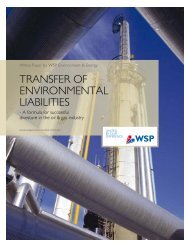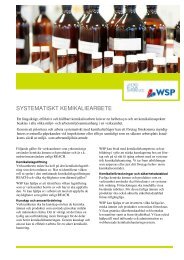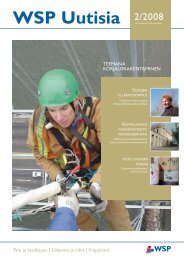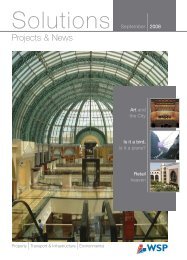Projects & News - WSP Group
Projects & News - WSP Group
Projects & News - WSP Group
- No tags were found...
You also want an ePaper? Increase the reach of your titles
YUMPU automatically turns print PDFs into web optimized ePapers that Google loves.
Solutions June<strong>Projects</strong> & <strong>News</strong>2009Risk-freewhiskyWorld CupKick OffPlatform forimprovement
Solutions June<strong>Projects</strong> & <strong>News</strong>2009CONTENTS02 Risk-free whisky04 World Cup Kick Off06 Placing a priceon your footprint08 Platform for improvement10 The Obama effect11 Scents of time11 Work starts on the Shard12 MilestonesFront Cover: Laurie Chetwood’s winninggarden at RHS Chelsea Flower Show.Editor: Bridget Kennerley,<strong>WSP</strong> <strong>Group</strong> Communicationsbridget.kennerley@wspgroup.comAssociate Editor: Carrie Bridgwood,<strong>WSP</strong> <strong>Group</strong> Communicationscarrie.bridgwood@wspgroup.comDesigned and printed byrhc visual strategy www.rhc.uk.comIn these difficult timesit’s very pleasing to readabout the many positiveactivities going on in <strong>WSP</strong>,and in particular a numberof features that point to thebenefits of our long-termstrategy of diversification intomarkets, sectors and regions.Opposite you can read about two industrialprojects we are delivering to two whiskymanufacturers in Scotland and, believeit or not, Sweden! These illustrate our expandingand increasingly diverse global industrial sectorthat we have been successfully developinginto an important core division with activitiesin Scandinavia and South Africa, and morerecently complemented by the acquisitionof CEL International in 2007.We’re also increasing our presence in the railsector, building on the existing strong platformof <strong>WSP</strong> Sweden with significant recent progressin the UK. Here we’ve been appointed to somehigh profile station refurbishments, as describedin our special feature on P8, which also describesan award-winning station project in Australia.In addition, we hope to participate in the futuredevelopment of Crossrail.Regional diversity is also proving to be anadvantage, with strength in countries lessaffected by the downturn balancing the problemsexperienced in more difficult markets. For example,Andrew Mather, MD of <strong>WSP</strong> Africa, describeson P4 how his country has, to date, beenrelatively protected from the global downturn,as well as benefiting from investment in theregion’s infrastructure, stadiums and tourismin preparation for next year’s FIFA World Cup.This edition of Solutions also celebrates diversityon a very local scale, with two contrasting projects– the Shard of Glass, now under construction,and the small but technically demandingstructure for an award-winning garden forthe 2009 RHS Chelsea Flower show – showcasingthe wide-ranging skills of our London structuralengineers working on two very different schemes.I believe it is this diversification of skills,sectors and geographies, together with yourcommitted support, that will ensure we continueto be a successful company through therecession and well positioned for the upturn.Chris Cole CEO, <strong>WSP</strong> <strong>Group</strong> plcRisk-free02
Andrew MatherIn the run up to the2010 World Cup,<strong>WSP</strong> Africa’s CEOAndrew Mathertalks to Solutionsabout the impacton both the countryand the company.World CupQ: How has South Africa beenaffected by the global economicdownturn?A: We’re part of the global village,so the credit crunch still has an impact.But we’re sheltered from its effectsby a number of drivers. The sanctionsfrom the apartheid era gaveus independence from the rest of theworld’s banking system. Once that wasa disadvantage but in recent monthsit has given us an advantage.Also, foreign exchange controls are verystrict – the amount that banks can investoffshore is capped at 15%. Again; thishas a protective effect. The governmentpassed a National Credit Act to preventloan sharks from exploiting the newlyempowered black population, whichhas prevented the sort of sub primeloans that have affected the restof the world. And preparations forthe World Cup have meant a massiveinfrastructure roll-out. Not just thestadia but roads, water, sewerage andaccommodation too. It’s propped up theconstruction industry for the past 2-3years and this will continue post-2010.Q: What about the rest of Africa?A: Currently there’s foreign investmentbeing poured into other Africancountries – the US is investingin West African oil production andChina is investing heavily in thecontinent’s mineral wealth. The existinginfrastructure is of poor quality, whichmeans huge potential for projects andinvestments in these countries. Thisin turn means growth for <strong>WSP</strong> Africa.Q: How is <strong>WSP</strong> Africa being affectedby global recession?A: The company’s strength is thatit’s highly diversified. Sectors thatare currently seeing a mini-boom arerefrigeration consulting and marinecoastal, which is doing a lotof international work. Facilitiesmanagement and traffic planningContact: Andrew Mather, <strong>WSP</strong> AfricaTel: +27 11 3611300Email: andrew.mather@wspgroup.co.zaPreparations forthe World Cup havemeant a massiveinfrastructure roll-outare also expanding. The global decreasein tourism is being offset by the buildingof hotel accommodation for theWorld Cup, and in addition to our inputinto stadia, we are involved in Gautrain –the first light rail in South Africa –and airport and motorway upgrades.Q: What about the energy sector?A: South Africa has a history of verycheap power because of its coalresources but we’re under pressureto move away from coal: the price is risingsharply and there’s been a significantincrease in electricity tariffs. Recentmassive growth has meant the powergrid struggling to keep up with demand,so the government has introduceda saving plan whereby businesses must04
Match FitKick OffA year before the 2010 FIFA World Cupkicks off, the Nelson Mandela Baystadium in Port Elizabeth is ready for itsfirst big event, a rugby match betweenthe British & Irish Lions and Coastal XV,on June 16th. <strong>WSP</strong> in Cape Town wasmechanical lead consultant and providedelectronic services for the 46,000 seaterstadium, which will host 8 of theWorld Cup matches includinga quarterfinal and the third and fourthplace playoff match, and is the firstof the new stadia to reach completion.reduce demand by 20% or face hugepenalties. This will help counteract growthuntil new power stations come online.Companies now urgently need to reduceconsumption and <strong>WSP</strong> Africa has becomeinvolved in energy demand managementand co-generation from waste.Q: How have South Africa’s recentsocial changes affected thebusiness?A: In 1994 the ANC introducedmeasures to redress apartheid,literally giving the disenfranchised blackpopulation a stake in their country.A broader based black empowermentlegislation introduced in 2008 has ledto increased investment in training andsocial responsibility. <strong>WSP</strong> Africa alreadyhas a history of this, and has becomeinvolved in enterprise developmentof black owned companies in which<strong>WSP</strong> has a minority share. It meansan increase in the level of our publicsector work.Q: How do South Africans feel aboutthe 2010 World Cup?A: Soccer is the passion of largesections of the population, so there’shuge popular support for the event.The job creation and infrastructureupgrade are currently driving theSouth African economy. We’re confidentthat stadia will be ready in time and thatthe systems will cope. South Africa alsohas a strong history of hosting globalsporting events: the 1995 rugby worldcup and the cricket world cup.Q: And after the World Cup?A: Right now everyone sees 2010as the thing that is saving us fromrecession. Post 2010, if the world is stillin recession, things could get harder.We need to be cautious and plan ahead.In March of this year, the last of thestadium’s 36 roof girders – each weighing50-70 tons and spanning 36 metres –was put in place. 2010 FIFA World CupOrganising Committee South Africa (OC)Chief Executive Officer, Dr Danny Jordaan,walked on the newly laid pitch andwas very happy with what he saw.“We’re delighted with the progressmade… It’s exciting to see a brandnew venue taking shape.”See our special South Africa 2010microsite for more information:www.wspgroup.com/southafrica201005
Andrew Bright,Technical Directorat <strong>WSP</strong> Environment& Energy, examinesthe commercialimpact of carbonfootprinting.Placing a price on your footprintWhat do whisky, Vitamin C, contactlens fluid, computer software, a multinationalconstruction company and ahigh street retailer all have in common?The answer is that <strong>WSP</strong> Environment& Energy has been advising companiesin all of these sectors on developingand understanding the carbon emissionsassociated with delivering theseproducts and services to the marketplace. The need for this process is clear– it’s now recognised that climatechange is a fact of life and is playinga growing role in business strategy.With carbon emissions beingincreasingly examined, regulatedand priced, understanding the impacta product, a project or an organisationhas on carbon emissions has neverbeen more important. It can helpmaintain a competitive advantage andadapt to changes in the market placeand also to the possible physicalimpacts of climate change.Understanding carbon emissionsis not just an operational issue,but can offer key strategic advantageto organisations that have a clear pictureof their carbon emissions and whatimpact a changing climate may haveon their business model.One of the most effective waysof doing this is to understand thecarbon footprint of a product, projector even a whole organisation. To be trulystrategic, this has to be done rightthrough the value chain to measure thecarbon dioxide and other greenhousegases. This is then applied over the fulllife cycle of a product or service.This can be a complex undertaking,depending on the level of detail requiredand the client’s intended use for theinformation. <strong>WSP</strong> Environment & Energyhas developed a series of modelsto deliver detailed carbon footprintsat product, project and organisationallevel. A recent example looked at theContact: Andrew Bright, <strong>WSP</strong> Environment & EnergyTel: +44 (0)13 1344 2300Email: andrew.bright@wspgroup.comIt’s now recognisedthat climate change is afact of life and is playinga growing role inbusiness strategycarbon emissions associated withproducing a widely used food ingredient– Vitamin C – for a major globalmanufacturer. This involved developinga complex process map for a multiproductmanufacturing facility anddetermining the carbon emissionsassociated with the productionof the product. It included raw materialssupplied, the onsite processing and thefinal product distribution. The modelhas been independently verified andas a result, the product is now eligibleto carry a carbon label.We are currently advising a large multinationalproperty development and06
Highlights5,000000 m 3000 m 3Vehicle WashingShowersGlasswareCitrus growingLondon officeMadrid officeTirana officeThe food and drinkindustry consumeshundreds of billionsof litres of waterevery year, butwhere does thatwater come from?And what wouldhappen if thesupply dried up?Highlights‘Company X’ End to End Water Footprint 2009Traditional water footprints tell business only half the story. They either focus on just a company’s direct metered use or on individual products.<strong>WSP</strong> understands that our clients also need a high level overview across their business that incorporates the regions of water availability theyTotal ConsumptionWater in your supply chain (20,534,450 m 3 /yr)Ingredient Growing Processing GrowingDyeing Processing White Goods Consumer ElectronicsFOOD AND DRINK CLOTHINGWater in your operations (4,246,000 m 3 /yr)WCs Sinks CleaningSTORES / OFFICES WATER USEWater in the use of your goods and services (4,912,622 m 3 /yr)Washing MachineDishwasherWHITE GOODSMISC.00 1,000 2,000 3,000 4,000 5,000 6,000 7,000 8,000 9,000 10,000 11,000 12,000 13,000 14,000 15,000 16,000 17,000 18,000 19,000 20,000Water Availability - South America PRIORITYAbundant Stressed Extremely StressedWater availability in your supply chain (9,346,620 m 3 /yr)31% 39%30%Water availability in your operations (1,743,465 m 3 /yr)ELECTRICALMISC.GOODSArabica Coffee GrowingVineyard Irrigation SystemsSugar Cane GrowingMeat Processing0 5,00010,000South American head offices are located in Sao Paolo and Buenos AriesYour meat processing suppliers account for 20% of your extremely stressed water availabilityIrrigation of vines for wine production accounts for 17% of your stressed water availabilitySugar cane growing accounts for 11% of your extremely stressed water availabilityThe majority of your goods are exported to the USA and UK so negligible water availability impacts from the use of your products here.WCsWater Availability - EuropeAbundant Stressed Extremely StressedWater availability in your supply chain (2,314,071 m 3 /yr)PRIORITYWater availability in your operations (3,643,628 m 3 /yr)Water availability in the use of your goods and services (6,142,341 m 3 /yr)Your European head offices are located across Europe with 50% located with abundant water availabilityYour household items have a range of water availability impacts e.g. Glassware from Eastern Europe accounts for 10% of your stressed water availabilityFurniture Glassware Chinaware0 10,000Users of your white goods across Europe contribute significantly to gross water use and 20% of stressed and extremely stressed water availability in use.Washing Machines & Dishwasher use Mediterranean Europeconstruction business, to help themestablish the end-to-end carbon andecological footprint of the businessthroughout the world. The high levelstrategic project is now being furtherdeveloped to be used as a practical toolat project management level. This willboth establish the carbon intensityof individual projects and promotethe use of low carbon solutions, suchas renewable energy sources, specifyinglower carbon cements and lookingat waste generation and recycling.Of course knowing the carbonemissions associated with yourfavourite bottle of whisky doesn’tsave carbon. But it does help ourclients focus on the areas that will leadto significant reduction. These in turnare often areas where other partsof <strong>WSP</strong> <strong>Group</strong> can assist; with energysaving solutions, low carbon designand training and awareness.To try and answer these questions,<strong>WSP</strong> Environment & Energy haslaunched an innovative watercalculation tool which will allowcompanies to identify theirend to end water footprint.The tool measures three things:a company’s own water use, thewater use of their supply chain andthe “downstream” water consumptionof their products. Concerns about thewater footprint of imported Peruvianasparagus have recently been raised,for example, since the producton UK supermarket shelves is farmedin areas where water is becomingincreasingly scarce.Such communities are being exposedto future risk of water shortages dueto excessive and inefficient use of localsupplies. The uncertainties of howrainfall patterns will be affectedby climate change make it difficultto predict when and where droughtContact: Andrew Noone, <strong>WSP</strong> Environment & EnergyTel: +44 (0)16 1886 2675Email: andrew.noone@wspgroup.comwill occur. The tool therefore alsooffers an important interpretationof water “security” for a company’sfull operation, enabling them to protecta water-dependent supply chain likegrapes for wine production. Its resultswill identify areas of strategic focus forsustainability programmes.The tool works by using databasesto analyse lifecycles and produce grossconsumption figures compared againstregional water availability in the formof an output map. “It’s intuitive, highlygraphic and gives clients the abilityto plan the priority actions for theirown business,” says Andrew Noone,Consultant at <strong>WSP</strong> Environment & Energy.Clients from the food and drink industryare now in discussions to use thishigh-level approach to analyse theirwater footprint.07
Physics and EngineeringMelbourne’sSouthern Crossstation, described as“one of the world’smost extraordinaryspaces”, wasbuilt to replacethe dilapidated1960’s SpencerStreet facility.Previously an open plan station, it wasexposed to the elements, accessedby tunnels, and had a classic pre-warroof design. “There was no protectionfor commuters and the streets aroundthe station entrance were emptyand unused,” says Matthew Jessupof <strong>WSP</strong>’s Australian business,Lincolne Scott, which provideda wide range of services includingM&E and environmental; “So it createda disincentive to use public transport.”The new station is hard to miss, thanksto the undulating 10 hectares of its steelwave form roof spanning the largestundercover concourse in Australia.Situated in the heart of Melbourne’scentral business district, the station risesto twenty three metres above groundlevel at its highest point. The stationremained operational duringconstruction with about 50,000commuters passing through each day.Electric trains from the suburbs anddiesels from country towns run intothe station, as well as intercity trainsto Sydney.Lincolne Scott devised a low energysolution to disperse diesel fumes,Contact: Matthew Jessop, Lincolne ScottTel: +61 2 8907 0932Email: matthew.jessup@lincolnescott.comexhaust gases and hot air andto ventilate the space and admitdaylight. “We started with the processof looking at the roof form and howthat affected the behaviour of the windand the movement and storage of airand then tuned that to bring some sortof reliability to the systems,” saidChé Wall, Lincolne Scott’s ManagingDirector. “There are no mechanical fansdriving the ventilation of the building –it all relies on physics and engineering.”Lincolne Scott’s contribution hasbeen extended to include developingan environmental managementframework and materials advice.The station was finished in 2007 butmore platforms are currently beingintegrated and a new office buildingis being erected above the station.“The new station is an iconic pieceof public transport infrastructure andhas attracted new users to thenetwork,” says Jessup.Southern Cross station, Melbourne08
In the third part of our serieson refurbishment, we look at the workof redesigning busy city railway stations.Platform for improvementCapital ConnectionThe group’s rail business hasexpanded in the UK over the pastfive years using its existing buildingsexpertise on station related work.Winning the outline design contractfor Birmingham New Street Stationwas the first big step in this process.“<strong>WSP</strong> is now considered a leadingNetwork Rail station designer,”Our targetis to becomeone of the UK’sleading railwayconsultantsrailway stations in the UK. AnotherGrade II Victorian structure, the wroughtiron structural skeleton of the archedbarrel roofs will be strengthened andgrit blasted to protect it from corrosion.During the refurbishment, some11,000 sq m of elevated protectiondeck separate the work area from thepublic area. A further temporary stagingplatform complete with a tower cranehas been erected over an existingelevated car park to handle themovement of materials to and fromthe roof safely. A multi-disciplinary teamis working on this 18-month project.Reading StationWhen it comes torefurbishment ofstations in Londonand its immediatenetwork, <strong>WSP</strong> has animpressive andgrowing portfolio.explains Dave Darnell, Directorof <strong>WSP</strong> Rail. “Our target is to buildon our station capability and emulate<strong>WSP</strong> Sweden’s multi-disciplinaryrail capability to become one of theUK’s leading railway consultants.”Crystal PalaceStationWhen the East London Line Extensionopens, it will be from the renovatedCrystal Palace station. The existingGrade II listed station is an imposingexample of Victorian railwayarchitecture, built in 1854 following theGreat Exhibition. From May 2010 it willbecome one of the two southern terminiof the East London Line, connectingwith the London Overground network.<strong>WSP</strong> is providing full engineering designfor station enhancements, which includenew stairs, lifts and walkways, a newticket office and a state of the art fabricroof to the platforms.Victoria Station<strong>WSP</strong> is design consultant to NetworkRail’s Contractor May Gurney for theroof refurbishment of Platforms 1-8of Victoria Station, one of the busiestAn important railway hub servingPaddington and West London,Reading Station is in the early stagesof a comprehensive £500 millionredesign process to expand bothtrack and passenger capacity.The team from <strong>WSP</strong> is workingin partnership with Corus, Grimshawand Turner & Townsend on a schemethat will add several new platforms,provide a new 30m wide pedestrianbridge spanning the entire stationand refurbish the subway system.Paddington StationAs well as being the terminus for theHeathrow Express, Paddington willbecome an interchange on the £15.9bnCrossrail project. Following the detailedroof survey and the design of theambitious renovation of the station’sGrade I listed fourth roof span, <strong>WSP</strong>has been appointed to design a backuppower supply that would allow thestation to remain open and operationalin the event of its main power supplyfailing. The initial surveys involveda comprehensive programme of siteinvestigations and inspectionsundertaken by a multi disciplinary <strong>WSP</strong>team working under track possessionsand often during night time closures.Contact: Dave Darnell, <strong>WSP</strong> UKTel: +44 (0)12 5631 8712Email: dave.darnell@wspgroup.comVictoria Station Crystal Palace Station09
In February, the US Houseof Representatives votedto kick start the nation’seconomy with a $787.2billion stimulus package,the country's biggestspending plan sincePresident Roosevelt'sNew Deal in the 1930s.What do these measuresmean for <strong>WSP</strong> <strong>Group</strong>’sAmerican companies?Despite the new regime being an eraof firsts – the first black president, the firsttruly urban president – the initiatives areas much about cleaning up the oldas bringing in the new. They recognisethat in order to support a healthy economy,the current infrastructure needsimmediate updating. Urban brownfieldsites will be redeveloped and America’sinventory of public buildings willbe refurbished after decades of neglect.According to David Cooper, CEOof <strong>WSP</strong> Flack + Kurtz, this also meansthe greening of existing governmentbuildings – schools, courthouses andcity halls – to reduce their carbonfootprint and make them energyefficient. “In keeping with the Obamaadministration’s focus on climate change,a substantial amount of stimulus moneyis being made available for the upgrade,modernisation and greening of publicbuildings. Energy efficiency andsustainability have been the cornerstoneof our practice for the past 30 years, butto date, the public sector has contributedonly 20% of our overall business.That’s likely to increase significantly.”He acknowledges that the stimuluspackage cash does not mean theindustry is suddenly on Easy Street.“It’s a very tough climate to competein and winning work will be very feedriven. But <strong>WSP</strong> Flack + Kurtzis in a good position; we havea great portfolio of public work,relationships with relevant agencies,great sustainability credentials anda strong engine to deliver our services.”There will also be a revitalisation of thetransport infrastructure, with $18 billionallocated to roads and bridges and$8 billion to high speed rail transit.About 10% of this money hasto be spent in 2009 and a further 60%A substantialamount ofstimulus moneyis being madeavailable forthe upgrade,modernisationand greeningof public buildingsin 2010. <strong>WSP</strong> SELLS is well positionedto benefit from the spending plan and hasalready had three of its on-call publicsector engineering contracts increasedby a total of $6 million to assist Stateagencies in performing stimulus work.CEO Steven Smith says: “Getting themoney into the system as earlyas possible is vital to get the economymoving. The injection of governmentmoney will in turn free up private fundingfor other projects.” He points out thatthe preparation process to identifyprojects that meet criteria for thestimulus money has been going on forup to nine months, and constructionwill probably extend into 2012.“It’s an investment in the country’sfuture. The work will generate jobs andhelp get the economy moving. From ourperspective it’s already been positivebecause work has come to us thatwe wouldn’t otherwise have.”Chris Jones, Director of <strong>WSP</strong>Environment & Energy believes that thecommitment of Obama to the creationof a ‘green’ economy also representsa major growth opportunity forThe Obama effectcompanies operating in the privatesector, although he cautions that“Policy makers must balance the urgentneed to stabilise the economy witha commitment to addressing the longerterm strategic policies and goalsset out by the new president.”To tackle climate change, followingCalifornia’s lead, Obama is promotinglegislation that will implementan economy-wide cap and tradeprogram, committing the US to reducingcarbon emissions by 80% below 1990levels by 2050. The recently approvedAmerican Recovery and ReinvestmentAct also signals Obama’s intentto promote energy independencethrough clean and renewable energytechnologies, as well as major upgradesto transmission and distribution systems.Jones believes that <strong>WSP</strong> Environment& Energy is well placed to capitaliseon these opportunities, citing <strong>WSP</strong>’sstrengths in corporate greenhousegas and energy management, greenbuildings, clean and renewable energytechnologies and the company’sexperiences with cap and tradein Europe. “But while the long termprospects for the sector in the US areundoubtedly good, current economicconditions will make for a toughoperating environment in 2009.”Jones concurs with David Cooper’sview that the greening of governmentbuildings is a major opportunity for <strong>WSP</strong>.“The Federal government is by far thebiggest owner and occupier of realestate in the US, so when it takes actionto ‘green’ its properties, the rest of thesector sits up and takes notice.”10
The 2009 RHSChelsea FlowerShow’s MostCreative Awardwent to a gardendesigned by architectLaurie Chetwood incollaboration with<strong>WSP</strong>, Gazeley andP&G PrestigeProducts.Contact: Ron Slade, <strong>WSP</strong> UKTel: +44 (0)20 7314 5175Email: ron.slade@wspgroup.comScentsof timeThe Elizabethan Perfume Gardenis a unique fusion of 16th centuryhistory and 21st century sustainability.Inspired by an original rosewaterrecipe created for Elizabeth I herself,the garden not only provides themeans of growing the flowers, butof distilling and bottling the scent too.Every plant in the garden – includingroses, lavender and ferns – is involvedin the creation of the scent, and theshape of the central stainless steelperfumery disguises photovoltaic cellsand rainwater harvesting systems.The perfumery is surrounded by clippedconifers and a cedar garden wall,incorporating ecological features suchas insect ‘hotels’, as well as wet anddry habitats.<strong>WSP</strong> provided the engineering designfor the central feature, a cable-stayedmast supporting fabric ribbons arrangedin concentric descending spirals.Director Ron Slade, says: “We wantedto make sure the final compositionwas not over-structured. This involvedcareful derivation of realistic wind loadingand the detailed 3-D analysis of thisgeometrically complex structure.”Photo credit: Laurie ChetwoodWork starts on the ShardWork has started on the Shard of Glasstower at London Bridge Quarterprompting wide-spread interest in <strong>WSP</strong>’sstructural design work on the project.The Shard is believed to be the world’sfirst skyscraper to use a top-downconstruction method for its structuralcore. The basement, including the core,will be constructed from the ground floordown at the same time as the 80-storeystructure is constructed from the groundfloor up.Project Director Kamran Moazami said:“We were intending to build the corebottom up, but it was going to take toolong. Instead we’re going for a topdown strategy including the core.”Top-down construction for basementsfrom ground level is a common designsolution for constrained sites wherestorage is an issue. On the Shard,following the installation of the pilesand basement plunge columns,the ground floor slab will be built,creating a surface for the storageof materials while constructionof the basement continues beneath.The tower is being built by contractorMace for Sellar Property <strong>Group</strong> andit is designed by architect Renzo Piano.Contact: Kamran Moazami, <strong>WSP</strong> UKTel: +44 (0)20 7314 4672Email: kamran.moazami@wspgroup.com11
MILEST NES■ The Roads and Transport Authorityin Dubai has appointed <strong>WSP</strong>to undertake a study into thedevelopment of a flexible parkingfee policy covering the city.■ <strong>WSP</strong> continues to strengthenits UK public sector profilewith framework appointmentsto Scotland – Excellence in HealthcareConstruction, and the universitiesof Westminster and Leeds.■ The Smithsonian Institutionin Washington, DC awarded the teamof Freelon Adjaye Bond/Smith <strong>Group</strong>the design for the National Museumof African American History andCulture. <strong>WSP</strong> Flack + Kurtz willprovide all MEP/FP engineeringservices for the $500 million project.<strong>WSP</strong> has beenappointed to providestructural designfor Peel Holdings’Wirral Water Scheme,a £4.5 billion mixeduse regenerationscheme in Liverpool.■ <strong>WSP</strong> is part of a team commissionedto provide transport, master planning,town planning and developmentadvice for Jersey Airport in theChannel Isles.■ Lincolne Scott’s Adelaide officehas secured a AUD$100 millionoffice tower project. Their specialistAdvanced Environmental serviceis overseeing the environmentaloutcomes, including 5 star GreenStar Office Design, As-Built andOffice Interiors and 5 star NABERSEnergy targets.<strong>WSP</strong> SELLS has beenawarded a $5 millionroad and bridgeengineering on-callcontract from theMassachusettsHighway Department.■ CEL International has successfullycompleted and handed over twoprojects in China - a US$27 millionchemical manufacturing facility forArch Chemicals in Suzhou, JiangsuProvince and a Technical ServiceCentre for Pielcolor (part of StahlInternational) in Guangzhou,Guangdong Province.■ In Singapore, Lincolne Scott Ng’sAnson Road Office Tower projecthas just been awarded BCA’s highestcertification Green Mark Platinum.Lincolne Scott Ng provided the fullrange of M&E consultancy servicesfor this S$80 million project.■ <strong>WSP</strong> Africa has received thecivil, structural and mechanicalappointment on a 135-key hotelbeing developed by Southern Sunin Witbank.■ In Denmark, <strong>WSP</strong> is part of thewinning team in a competitionto design a new school, library andafter-school care facilities in Ørestadon the outskirts of Copenhagen.Head Office<strong>WSP</strong> House 70 Chancery LaneLondon WC2A 1AF United Kingdom■ The American Council of EngineeringCompanies, New York, has conferredits highest award, the Diamond Awardin Engineering Excellenceto <strong>WSP</strong> SELLS, for maturity testing forbridge deck rapid replacement on theI-278 Gowanus Expressway Viaductin Brooklyn, NY; and to <strong>WSP</strong> CantorSeinuk, for the design of Citi FieldStadium – the new state-of-the-arthome venue for the New York Mets.■ Areva Resources Namibia haveappointed <strong>WSP</strong> Coastal Engineersfor the design, engineering andmanagement of the marinecomponent of a desalinationproject to supply potable waterto a new uranium mine at Trekkopjein Namibia.■ <strong>WSP</strong> Finland has been awardeda water and sanitation projectin Vietnam by the Finnish Ministry forForeign Affairs and the Governmentof Vietnam.■ Terje Røstbø has been appointedas MD for <strong>WSP</strong> Romania,based in Bucharest.<strong>WSP</strong> Finlandis to producegeotechnical, trackand rock engineeringplans for the HelsinkiWestern Metro.■ <strong>WSP</strong> International Sweden is involvedin two bridges crossing the Zambeziriver in Mozambique. Following thesuccessful completion of the bridgeat Caia, <strong>WSP</strong> has been awarded thesupervision of the rehabilitation worksfor the one kilometer long suspensionbridge in Tete, built in 1973.New school in Ørestad

















